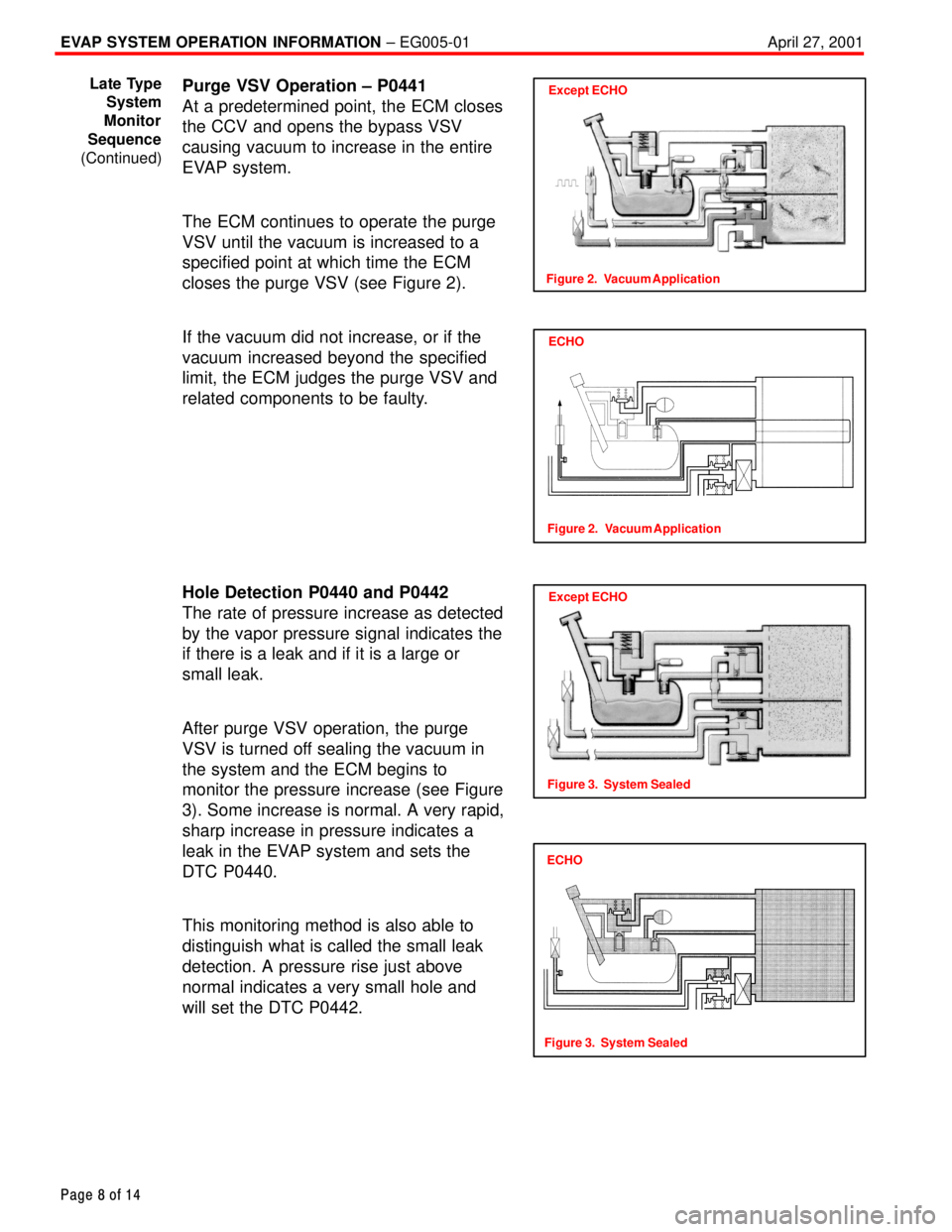Page 3514 of 4592
R07653
SR06G±01
F01477
SR±8
± STEERINGSTEERING WHEEL
2103 Author�: Date�:
STEERING WHEEL
INSPECTION
1. CHECK STEERING WHEEL FREEPLAY
With the vehicle stopped and tires facing straight ahead, rock
the steering wheel gently back and forth with light finger pres-
sure.
Freeplay should not exceed the maximum.
Maximum freeplay: 30 mm (1.18 in.)
2. CHECK STEERING EFFORT
(a) Center the steering wheel.
(b) Remove the steering wheel pad.
(See page SR±11)
(c) Start the engine and run it at idle.
(d) Measure the steering effort in both directions.
Reference: 5.9 N´m (60 kgf´cm, 52 in.´lbf)
HINT:
Be sure to consider the tire type, pressure and contact surface
before making your diagnosis.
(e) Torque the steering wheel set nut.
Torque: 35 N´m (360 kgf´cm, 26 ft´lbf)
(f) Install the steering wheel pad.
(See page SR±16)
Page 3806 of 4592

EVAP SYSTEM OPERATION INFORMATION ± EG005-01 April 27, 2001
Page 8 of 14
Purge VSV Operation ± P0441
At a predetermined point, the ECM closes
the CCV and opens the bypass VSV
causing vacuum to increase in the entire
EVAP system.
The ECM continues to operate the purge
VSV until the vacuum is increased to a
specified point at which time the ECM
closes the purge VSV (see Figure 2).
If the vacuum did not increase, or if the
vacuum increased beyond the specified
limit, the ECM judges the purge VSV and
related components to be faulty.
Hole Detection P0440 and P0442
The rate of pressure increase as detected
by the vapor pressure signal indicates the
if there is a leak and if it is a large or
small leak.
After purge VSV operation, the purge
VSV is turned off sealing the vacuum in
the system and the ECM begins to
monitor the pressure increase (see Figure
3). Some increase is normal. A very rapid,
sharp increase in pressure indicates a
leak in the EVAP system and sets the
DTC P0440.
This monitoring method is also able to
distinguish what is called the small leak
detection. A pressure rise just above
normal indicates a very small hole and
will set the DTC P0442.Except ECHO
Figure 2. Vacuum Application
Late Type
System
Monitor
Sequence
(Continued)
ECHO
Figure 2. Vacuum Application
Except ECHO
Figure 3. System Sealed
ECHO
Figure 3. System Sealed
Page 3897 of 4592
SUSPENSION BALL JOINT INSPECTION ± PG027-02December 4, 2002
Page 6 of 8
NOTE:
�Be sure to check the table for the
applicable inspection type based on
the vehicle model.
�Refer to the table for the standard
free play values.
1. Inspect Lower Ball Joint Free Play
A. Move the hub up and down by
hand (most models with wishbone
suspension):
a. Remove the tire.
b. Install the 2 lug nuts.
c. Inspect the free play while
moving the lug nuts up and
down at a force of 67 lbf
(294 N, 30 kgf).
B. Move the lower arm using a lever
(some models with double
wishbone type suspension):
a. Lift up the vehicle.
b. Place the tip of the lever to the
wheel and inspect the free
play while moving the lower
arm up and down.
C. Move the lower arm by hand (all
models with strut type suspension
and some models with wishbone
type suspension):
a. Lift up the vehicle.
b. Inspect the free play while
moving the lower arm up and
down at a force of 67 lbf
(294 N, 30 kgf).
On±Vehicle
Inspection
Page 3898 of 4592

SUSPENSION BALL JOINT INSPECTION ± PG027-02December 4, 2002
Page 7 of 8
2. Inspect Upper Ball Joint Free Play
A. Move the upper arm by hand
(models with the LOWER control
arm linked by a torsion bar, and
all models using a coil spring).
a. Remove the front tire.
b. Inspect the free play while
moving the upper arm up and
down at a force of 67 lbf
(294 N, 30 kgf).
B. Move the tire with a lever (models
with the UPPER control arm
linked by a torsion bar).
a. Lift up the vehicle.
b. Place the lever under the tire,
and inspect the free play while
lifting the tire using a wooden
stick, etc., as a fulcrum.
3. Inspect the Suspension Arm Ball
Joint Free Play
A. Lift up the vehicle.
B. Inspect the free play while moving
the control arm by hand.
(Reference)
Free Play Inspection Method
(Gauge Installation)
�Position the dial gauge between the
arm (upper or lower) and the knuckle,
and measure free play.
(This illustration shows how to
measure free play for vehicles with
double wishbone type suspension
with coil spring.)
4. Inspect Ball Joint Dust Cover
Check for cracks and grease leaks on
the dust cover (boots).On±Vehicle
Inspection
(Continued)